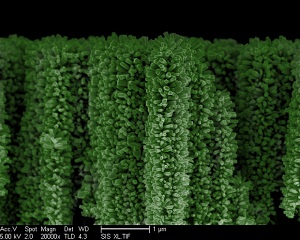Guest Editorial: Nanotrees—the future of solar energy
 Growing concern over rising greenhouse emissions and climate change has led many people to feel a drive to develop cleaner, cheaper methods of energy production. Solar energy is one such method that has seen a boom of development and purchase over the past several years due to the attractiveness of harvesting solar energy for use on Earth. Electrical engineers from the University of California, San Diego are working on a revolutionary form of solar energy gathering that they call nanotrees.
Growing concern over rising greenhouse emissions and climate change has led many people to feel a drive to develop cleaner, cheaper methods of energy production. Solar energy is one such method that has seen a boom of development and purchase over the past several years due to the attractiveness of harvesting solar energy for use on Earth. Electrical engineers from the University of California, San Diego are working on a revolutionary form of solar energy gathering that they call nanotrees.
Nanotrees are made by placing a silicon nanowire in a liquid zinc solution. The wire undergoes a chemical reaction and grows zinc oxide branches. Nanotrees are, as their name implies, extremely small; approximately 10,000 nanotrees could fit on the cross-section of a human hair. Over a million nanotrees are needed in order to form a one-square-centimeter photoelectrochemical cell, which is then placed in another solution and exposed to sunlight.
The vertical structure of a nanotree makes it a better gatherer of solar energy than its flatter counterparts. The nanotree's 3D branched nanowire array enables it to absorb light and to split water molecules more efficiently and cleanly. This structure also allows smaller hydrogen bubbles to be produced and absorbed, leading to the potential of higher hydrogen absorption efficiency. The 3D nature of nanotrees also means that the potential surface area for chemical reactions has increased by at least 400,000 times.
While the nanotree is an incredible advance in solar energy gathering technology, it is by no means fully developed. Nanotrees generate energy that can be hard to gather given the nature of hydrogen gas, meaning that efficiency is currently running around a sub-par three percent. Its developers intend to develop a half cathode and half anode cell that would convert the hydrogen more efficiently and also use it to produce clean energy. They are also trying to address stability problems arising from the nature of zinc oxide being prone to corrosion.
In addition to addressing these problems, the UCSD team is aiming still higher. Their goal is to eventually create a nanotree that can artificially mimic photosynthesis. If these engineers can accomplish this feat, then they would have an artificial construct that could mimic photosynthesis and thus capture carbon dioxide from the atmosphere, lowering greenhouse gas emissions while also producing energy. While this function of a nanotree is far from completed, the engineers remain hopeful that they will be able to produce such a nanotree in the future.
A complete switch from fossil fuels to solar power is still years away, but that does not mean that strides in the right direction such as the nanotree should not be celebrated by all who wish to employ cleaner, cheaper energy.
Maybe someday decades from now, people will be able to fully switch from gas and oil power to nanotree-constructed solar power. Scientists and engineers will have to figure out more efficient ways of harvesting hydrogen and splitting water molecules, but the immense strides already made with the nanotree suggest that such progress is, if not imminent, at least on the horizon.
Solar power is part of the future and the present.
Author Allison Brooks is a recent biomedical anthropology graduate and contributes to the blog Musings of a Curious Mind.



